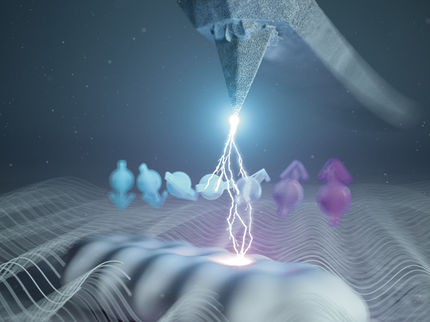Researchers Take First Look into the “Eye” of Majoranas
Majorana fermions are particles that could potentially be used as information units for a quantum computer. An experiment by physicists at the Swiss Nanoscience Institute and the University of Basel’s Department of Physics has confirmed their theory that Majorana fermions can be generated and measured on a superconductor at the end of wires made from single iron atoms. The researchers also succeeded in observing the wave properties of Majoranas and, therefore, in making the interior of a Majorana visible for the first time.

Atomic force microscopy image of the end of a mono-atomic iron wire. The individual iron atoms are clear to see, as well as the “eye” of the Majorana fermions on the end.
University of Basel, Department of Physics
Around 75 years ago, Italian physicist Ettore Majorana hypothesized the existence of exotic particles that are their own antiparticles. Since then, interest in these particles, known as Majorana fermions, has grown enormously given that they could play a role in creating a quantum computer. Majoranas have already been described very well in theory. However, examining them and obtaining experimental evidence is difficult because they have to occur in pairs but are then usually bound to form one normal electron. Ingenious combinations and arrangements of various materials are therefore required to generate two Majoranas and keep them apart.
Collaboration between theory and practice
The group led by Professor Ernst Meyer has now used predictions and calculations by theoretical physicists Professor Jelena Klinovaja and Professor Daniel Loss (from the Swiss Nanoscience Institute and the University of Basel’s Department of Physics) to experimentally measure states that correspond to Majoranas. On a superconductor, the researchers evaporated single iron atoms with spin that, due to the row structure of the lead atoms, arrange themselves into a minute wire comprising one row of single atoms. The wires reached an astounding length of up to 70 nanometers.
Single Majoranas on the ends
The researchers examined these mono-atomic chains with the aid of scanning tunneling microscopy and, for the first time, with an atomic force microscope as well. Using the images and measurements, they found clear indications of the existence of single Majorana fermions on the ends of the wires under certain conditions and from a specific wire length on.
Despite the distance between them, the two Majoranas on the ends of the wires are still connected. Together, they form a new state extended across the whole wire that can either be occupied (“1”) or not occupied (“0”) by an electron. This binary property can then serve as the basis for a quantum bit (Qubit) and means that Majoranas, which are also very robust against a number of environmental influences, are promising candidates for creating a future quantum computer.
Predicted wavefunction measured
The researchers from Basel have not only shown that single Majoranas can be generated and measured at the ends of an iron wire, they also performed the first experiment to show that Majoranas are extended quantum objects with an inner structure, as predicted by their theory colleagues. Over an area of several nanometers, the measurements showed the expected wavefunction with characteristic oscillations and twofold decay lengths, which have now been made visible for the first time.
Original publication
Original publication
Rémy Pawlak, Marcin Kisiel, Jelena Klinovaja, Tobias Meier, Shigeki Kawai, Thilo Glatzel, Daniel Loss, and Ernst Meyer; "Probing atomic structure and Majorana wavefunctions in mono-atomic Fe chains on superconducting Pb surface"; npj Quantum Information; 2016
Topics
Organizations
Other news from the department science

Get the chemical industry in your inbox
By submitting this form you agree that LUMITOS AG will send you the newsletter(s) selected above by email. Your data will not be passed on to third parties. Your data will be stored and processed in accordance with our data protection regulations. LUMITOS may contact you by email for the purpose of advertising or market and opinion surveys. You can revoke your consent at any time without giving reasons to LUMITOS AG, Ernst-Augustin-Str. 2, 12489 Berlin, Germany or by e-mail at revoke@lumitos.com with effect for the future. In addition, each email contains a link to unsubscribe from the corresponding newsletter.

























































